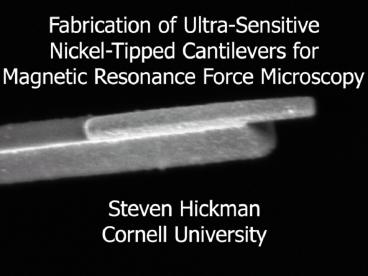Batch Fabrication of Ultrasensitive Cantilevers with Overhanging Nanomagnet Tips - PowerPoint PPT Presentation
1 / 18
Title:
Batch Fabrication of Ultrasensitive Cantilevers with Overhanging Nanomagnet Tips
Description:
xmlns:tiff='http://ns.adobe.com/tiff/1.0/' tiff:Make Canon /tiff:Make tiff:Model Canon PowerShot G3 /tiff:Model tiff:Orientation 1 /tiff:Orientation ... – PowerPoint PPT presentation
Number of Views:81
Avg rating:3.0/5.0
Title: Batch Fabrication of Ultrasensitive Cantilevers with Overhanging Nanomagnet Tips
1
(No Transcript)
2
Magnetic Resonance Force Microscopy
30 nm Fe magnet, 5 nm away from a single
proton F 1.3 aN
4.2K minimum detectable force Fmin 2.9 aN (1 Hz
bandwidth)
3
Minimize Surface Noise Gs
- Friction less for metal than silicon tips
- Friction decreases with tip cross-section
- Both decay to background level when gt100 nm away
from the sample - Make metal tips that extend 100 nm from end of
cantilever
S. Kuehn, R. F. Loring, J. A. Marohn, Phys. Rev.
Lett, 96 156103 (2006)
Measurements at 300K, over a gold surface
4
Cantilever Design
220 by 100 nm by 1.5 micron Co magnet
Body design long, narrow, and very thin to
minimize intrinsic dissipation
5
Other Fabrication Methods
- Focused Ion Beam Milling
- Cantilever below used to detect single e- spin2
- Ion damage
- Slow, serial process
- Hand-Gluing
- Cantilever below set MRFM sensitivity record of
6.0 105 mp in 20041 - Serial process
- Limited to 1mm minimum particle size
1 S. R. Garner, S. Kuehn, J. M. Dawlaty, N. E.
Jenkins, J. A. Marohn, Appl. Phys. Lett, 84 5091
(2004) 2 D. Rugar, R. Budakian, H. J. Mamin, B.
W. Chui, Nature 430, 329 (2004)
6
Other methods for small magnet tips
1
- Focused-ion-beam deposited metal pillars1
- Metal coated or metal filled carbon nanotubes2,4
- Metal nanowires attached to cantilevers3
- All serial processes
- Device to device variation
- magnetic material
3
2
Scale bar 100 nm
1 Y. M. Lau, P. C. Chee, J. T. L. Thong, V. Ng,
J. Vac. Sci. Tech. A 20, 1295 (2002) 2 Z. Deng,
E. Yenilmez, J. Leu, J.E. Hoffman, E.W.J.
Straver, H. Dai, K.A. Moler, Appl. Phys. Lett.
85, 6263 (2004) 3 G. Yang et. al., Appl. Phys.
Lett. 87, 123507 (2005) 4 F. Wolny et. al., .
Appl. Phys. 104, 064908 (2008)
7
Cantilever and tip fabrication from SOI wafer
8
Fabricating Overhanging Magnets
- SF6 RIE process done using an Oxford Plasmalab 80
- No magnet damage observed
- Isotropic Plasma Etching
All Ni magnets, scale bars 200nm
9
Fabricating Overhanging Magnets
- Magnets Over Oxide
- Fabricate magnets partially over oxide pillars
coplanar with device layer silicon - Create by localized oxidation
- KOH etching
- Careful design and placement of etched pit around
magnet - Requires lt111gt SOI wafers
Magnet
Oxide
Device Silicon
10
(No Transcript)
11
What took 2 years?
- Already produced large non-overhanging magnets on
similar cantilevers - After release, magnets damaged or gone
- HF etch? O2 plasma? Poor adhesion? KOH damage?
- Testing ruled these out
5 mm
12
Metal Silicides!
- Ni (and Co) both form silicides around 200C1,2
- Heating in Bosch etch transforms magnet material
to metal silicide - Cantilever sandwiched between oxide layers,
little possibility for heat dissipation
g He cool
BOSCH etch
1L. A. Clevenger, C. V. Thompson, J. Appl. Phys.
67, 1325 (1990) 2H. Miura, E. Ma, C. V.
Thompson, J. Appl. Phys. 70, 4287 (1991)
13
Preventing silicides
- Metal Barrier Layer
- Try to prevent Co/Ni diffusing to the Si
interface - Tried 20nm Cr, Ti, Ta layers
- Test via 500C anneal
- None worked
Cr
.6 x 1.5 um x 200 nm Co on 20nm barrier layer
- Heat Management
- Heating only issue for last 100mm of backside Si
etch - No protective front oxide
- Potassium hydroxide etch
- Slow Bosch etching
- Cryogenic etching
14
Cantilever Magnetometry
- Frequency shift versus applied field
- Gives particle magnetic moment
- Required
- a) cantilever spring constant
- b) magnet dimensions
- Time consuming
- Cantilever shown at right Msat 0.40 T,
- Surface oxide or silicide layer?
J. A. Marohn et. al., Appl. Phys. Lett. 73, 3778
(1998)
15
Surface Dissipation
- Taken over a gold coated polystyrene film
- G calculated from
- k, Q, and f measured at each distance point
- Comparison data for a bare silicon cantilever
IBM Force sensitivity ?10 aN Hz-1/2 below h 24
nm Cornell Force sensitivity ? 10 aN Hz-1/2 down
to h 3 nm
16
Conclusions
- Overhanging magnet process viable by a variety of
methods - Cantilever fabrication viable with Ni magnets
- Silicide prevention essential
- Ni mostly intact importantly at leading edge
(see Marohn talk) - In force detection, few nm working distance
possible
17
Future Directions
- Sub-attoNewton sensitivity
- Cantilever at right is 340nm thick, 5mm wide, and
1.5mm long. - Theoretical Fmin 2aN at 4.2K
- Low frequency noise issues
- Smaller magnets
- Smaller magnets gt larger force gradient, less
friction - Magnet at right is 45nm wide, 30nm thick Ni -
believe lt30nm possible
- Co and Fe magnets
- Co 1.6 T, Fe 2.2 T Sat. Mag.
- Co More susceptible to silicide, chlorine
contamination - Fe Rapidly oxidizes
- ALD SiO2 protective layer
18
Acknowledgements
- Sean Garner
- Seppe Kuehn
- Neil Jenkins
- Jonilyn Longenecker
- Eric VanWerven
- Eric Moore
- Sanggap Lee
- Lee Harrell
- Boyan Penkov
- Jay Van Delden
- Jeremy Ong
- John Marohn
- Army Research Office MURI
- National Institutes of Health (R01)
- Cornell Nanofabrication Facility (ECS 03-35765 )































